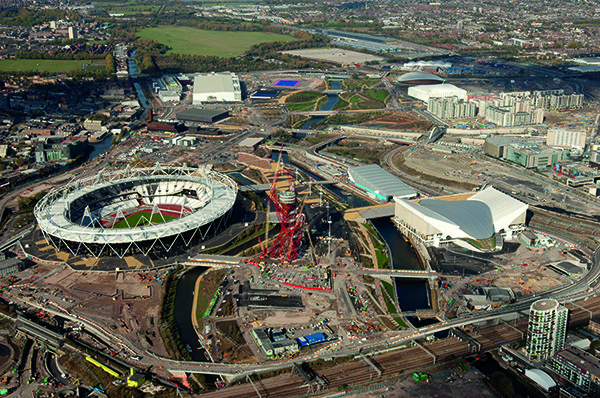 Since London 2012, most major projects require their occupational health strategy to deliver a 3Ws programme. Karen Baxter explains how this pioneering approach came about and why it’s so important for construction.
Since London 2012, most major projects require their occupational health strategy to deliver a 3Ws programme. Karen Baxter explains how this pioneering approach came about and why it’s so important for construction.
Nearly 10 years ago, London won the bid to host the Olympic Games. One of the most important reasons why London beat its competitors to staging the world’s most prestigious sports event was the focus on legacy – not only in terms of the social and economic regeneration of the local area but also a step change in sport and healthy living across the UK.
Looking at the Queen Elizabeth Olympic Park today, it’s hard to envisage that back in 2005 the 2.5-hectare site was a post-industrial landscape that had hosted chemical works, perfume factories, Hackney Fridge Mountain, domestic tips, scrap yards and a traveller site.
Before construction began on the site, Park Health was tasked with ensuring that occupational health and occupational hygiene issues were taken into consideration during the development. The team pioneered an occupational health strategy that delivered a worker, workplace and wellbeing (3Ws) programme. This same approach has become the blueprint for most major construction projects since then and a best practice model for the industry.
What does good look like?
 Given the legacy themes, it would have been wholly inappropriate to complete the Olympic development at the expense of those working on-site.
Given the legacy themes, it would have been wholly inappropriate to complete the Olympic development at the expense of those working on-site.
For safety, what this meant in practice was fairly straightforward. Based on the construction accident frequency rate at the time, and the number of working hours required, it was predicted that three workers would lose their lives during the build. Clearly, this was unacceptable, so the measure of success was indisputable – there should be no fatalities. This goal was achieved and was a first in Olympic build history.
Health, however, would be a harder nut to crack. Because of the long latency of occupational ill health, most exposures wouldn’t show up as a disease until years, possibly decades, later.
This posed several fundamental questions from the outset. What does an exemplary health programme look like? What should it include and what would it involve? All of these had to be answered before Park Health could devise and then deliver the strategy.
Through research and experience of working on previous projects (from Channel Tunnel to Terminal 5), the team looked into the reasons why health performance lagged behind safety so profoundly. It’s important to remember that this was 10 years ago when T5 was the acknowledged exemplar project.
The primary reason, they discovered, was the traditional approach. Health issues were dealt by a nurse based in a medical centre, isolated from the day-to-day activities on the construction site, waiting for workers to find their way to the door.
While this was going on, managers were struggling to get to grips with how to tackle health risks in the workplace. They cited numerous reasons – the causes of ill health weren’t obvious, outcomes were not predictable, historic exposures were the problem… it is lifestyle not work. Health was in the ‘too difficult’ box, left to medics to deal with, if it was dealt with at all.
Health like safety
It was clear that a different approach was required. To prevent the exposures that could lead to future occupational disease, the team needed to shift the emphasis from individual health monitoring and intervention to health risk assessment and workplace control. In short, it was about treating the causes not the symptoms.
From this starting point, Park Health came up with a team-based strategy to bring health out of the medical centre and ‘into the mainstream’ by positioning risk-management at the centre of the process. The team articulated this in the vision – a healthy worker, in a healthy workplace making healthy lifestyle choices.
Next, a business case was set out, highlighting the cost of getting it wrong and the benefit of getting it right. The team argued for the need to invest in a project-wide occupational health service that would focus not only on traditional clinical intervention (worker) but also ill-health prevention (workplace) and a comprehensive health promotion (wellbeing) programme.
A service of this kind would not only ensure that the legal duty to resolve any health issue was met but it would also focus on the lifestyle issues that could affect workers’ ability to perform at their best. Remember, the backdrop to 2005 was a booming economy and skills shortage. Park Health’s vision would be delivered operationally by linking health risk management to safety management – health like safety . The 3Ws strategy was born.
Prevention-led approach
Instead of medical staff determining what is provided based on the needs of individuals, prevention-led strategies are project-focused and engage with the design and delivery teams to weave ill-health prevention into all critical project steps.
This embodies workplace controls to protect health at the heart of the construction process. Rather than a bolt on to a traditional clinically-led model, this strategy requires occupational hygiene, with its dynamic of anticipation, recognition, evaluation and control, to become a vital element of the strategy, shaping everything that is done.
Best practice occupational health programmes are prevention-led because they influence workers’ future health outcomes in the following ways:
- Design – the first opportunity to prevent the exposures that can lead to ill health come many months before work on site begins – during design. HSEcommissioned research estimates that around 50 per cent of hazards can be eliminated at the design stage. Skilling up the design team so that they recognise the health implications of their decisions, by involving an occupational hygienist early on, will ensure that opportunities to eliminate health hazards or substitute them for healthier alternatives are seized.
- Residual risk mitigation – the proactive review of design risk registers will ensure that health hazards are appropriately identified and the necessary information made available by the client, lead designer etc. This risk profiling exercise will ensure that any lack of information at project commencement will neither delay contracts nor result in expenditure and, most important, workers will not be exposed to unidentified conditions or materials (asbestos, lead, contaminated land etc).
- RAMS review – as part of mobilisation (of all contracts, not just at initial site startup), a thorough review of risk assessments and method statements is vital to ensure that health hazards that are not eliminated or substituted at design stage are managed without reliance on protective equipment as the sole means of control. This can be achieved by ensuring the appropriate application of the principals of ill-health prevention and the hierarchy of control before work starts.
- Education, engagement and involvement – for a prevention-led strategy to be successful, it is essential that all workers, especially supervisors, engage with the ill-health prevention programme. This prevents workers from reverting to old ways and ensures that the superlative work achieved to date is not lost. In practice, interventions include daily activity briefings, on-site toolbox talks, site tours, exposure monitoring surveys etc. In addition, supervisors can be provided with training and coaching in how to communicate health issues and controls to their teams.
- Monitoring – as part of the assurance programme, the next responsibility of the project’s occupational hygienist is to identify when quantification is necessary. Quantification through exposure monitoring is used to verify that control regimes are reducing exposures to safe levels (below occupational exposure limits such as WELs, LEPDs, etc). If overexposure is identified, then the occupational hygienist will work with project teams to enhance controls thereby ensuring worker health protection.
- Lead indicators – another useful intervention in the war against occupational disease is to use lead indicators such as health impacts to create frequency rates that work alongside safety observation and near miss frequency rates. Working on the same basis, the health impact frequency rating (HIFR) focuses on the lowest common denominator in ill-health prevention – the equivalent of the near miss – the health impact.
- Continuous improvement – the use of project specific occupational health maturity matrices (OHMMs) to track improvement is another useful site-based intervention. Today, OHMMs are common self-assessment tools. Originally, however, they were used for third party benchmarking. Independent assessment by Park Health against the 3W parameters set out in the OHMM were used to output contractor specific improvement plans.
- Risk review – when early signs or symptoms of ill health are identified in workers onsite by occupational health professionals, it is up to the occupational hygienist to reactively assess the workplace to identify how the exposure that led to control failure came about. They then have to work with contractors to enhance the control regime so that it protects the health of workers that are undertaking similar work under similar circumstances (in occupational hygiene terms, the similarly exposed group or SEG). The need for this intervention is greatly reduced if the previous seven have been implemented successfully.
While this workplace-focused prevention model can be delivered in isolation, it returns best results when it is integrated with a wellbeing programme and a nurseled clinical solution that includes fitness for work, health surveillance, treatment clinic and emergency response.
A shout for wellbeing
Integrating wellbeing into the strategy means everyone is offered a mini health check. Otherwise, individual health issues may only be identified through a paper questionnaire or sometimes safety critical medicals of one sort or another.
Most importantly though, wellbeing programmes that deal appropriately with occupational risk (the employers’ risk to manage) and lifestyle risk (the workers’ risk to take) allow the link between health risks related to lifestyle and the workplace to be highlighted and the interdependence of these to be emphasised. This builds trust and engagement with workers in a way that isolated initiatives never could. The worker/workplace wellbeing programme was critical to the overall success of, not only the health programme on London 2012 but also safety, quality and production. In fact, it’s been said, the project as a whole.
As independent research shows, putting occupational hygienists together with occupational health practitioners provides the best of all worlds – a service that tackles both the symptoms of past exposures (occupational and lifestyle) while also preventing those that will lead to future ill-health. This balanced approach is fundamental to the 3Ws strategy.
Karen Baxter is co-founder and managing partner at the Park Health & Safety Partnership
What makes us susceptible to burnout?
In this episode of the Safety & Health Podcast, ‘Burnout, stress and being human’, Heather Beach is joined by Stacy Thomson to discuss burnout, perfectionism and how to deal with burnout as an individual, as management and as an organisation.
We provide an insight on how to tackle burnout and why mental health is such a taboo subject, particularly in the workplace.



